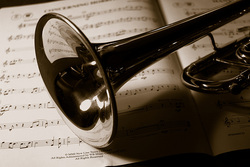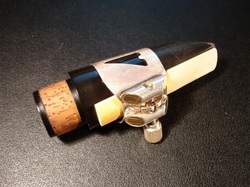Aerophones: What are they?
The final broad category of instruments that we find in the band room are called aerophones. These instruments are grouped together because they all produce a sound when a vibrating column of air passes through them. These instruments are then often subdivided into two categories called Brass Instruments and Woodwind Instruments. They reason they're split up is due to the way that the column of air enters the instruments.

Brass Instruments:
Sometimes referred to as wind instruments, this group include our trumpets, trombones, baritones, tubas, and french horns. They're called Brass instruments because brass is the material they are constructed out of. These instruments use a metal mouthpiece that the player "buzzes" into. As they buzz they produce a column of air which is sent into the narrow end of the metal tube called the resonator which the mouthpiece is attached to.
Sometimes referred to as wind instruments, this group include our trumpets, trombones, baritones, tubas, and french horns. They're called Brass instruments because brass is the material they are constructed out of. These instruments use a metal mouthpiece that the player "buzzes" into. As they buzz they produce a column of air which is sent into the narrow end of the metal tube called the resonator which the mouthpiece is attached to.

Woodwind Instruments:
This other subgroup is where we find our clarinets, saxophones, oboes, and flutes. The reason they're called woodwinds, is because these instruments (with the exception of the flute) produce a sound with a mouthpiece that has a thin piece of wood called a reed covering the opening. When air is forced in between the reed and the opening, it creates the vibrating column of air that then travels through the resonator and down the length of the instrument.
This other subgroup is where we find our clarinets, saxophones, oboes, and flutes. The reason they're called woodwinds, is because these instruments (with the exception of the flute) produce a sound with a mouthpiece that has a thin piece of wood called a reed covering the opening. When air is forced in between the reed and the opening, it creates the vibrating column of air that then travels through the resonator and down the length of the instrument.
Factors that affect Aerophones:
- Material: This is a huge factor for this category of instruments. Whether or not an instrument is made of brass, plastic, wood, or something else has a huge impact on the sound quality and timbre. Also, as we looked at above, the material used in the mouthpieces also has a direct impact on how these instruments produce a sound.
- Size: Again, we see how the size continues to also have a huge impact on the sound, as the length of the tubing here has a direct effect on how high or low an instrument sounds. Our flutes are very tiny in size, and sound very high in pitch, where as our Tuba is very big in size and sounds incredibly low as a result. Even in instrument families like Saxophones, the same principle applies. While the mechanisms used to play them are the exact same, the soprano sax sounds the highest because it is the smallest, and the baritone sax sounds the lowest because it's the largest.
- Shape: This is also a factor in how these instruments sound in a few different ways. With brass instruments, we sometimes talk about their shape in terms of being either conical (cone shaped, gradually getting larger) or cylindrical (even throughout like a cylinder) . This is making reference to the instrument's bore which is the interior shape of an instrument which determines how the air flows through it. This has a big impact on the instruments' timbre, in the same way the material it is constructed out of can. Some instruments are strictly conical in bore like the saxophone, where as others like flute are strictly cylindrical. Then there are instruments like the trumpet which combine the two, which sections that are cylindrical and sections that are conical! Furthermore, the shape and thickness of the mouthpiece or reed used, can also impact the sound qualities of the instrument, and even change the number of notes that a musician is able to create with their instrument.